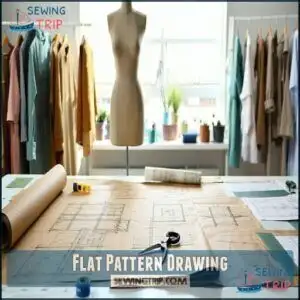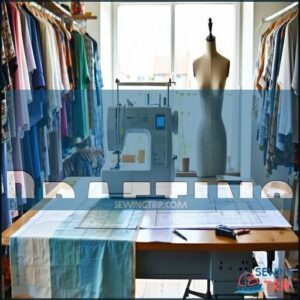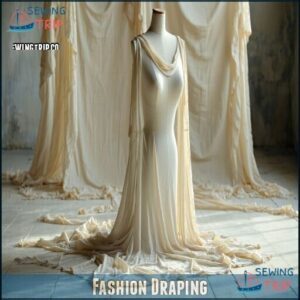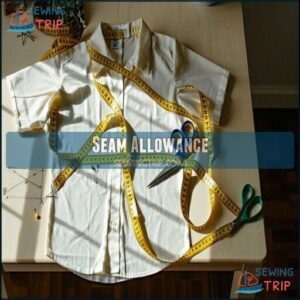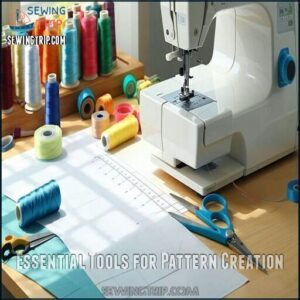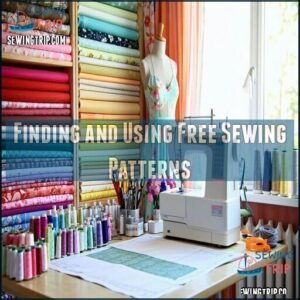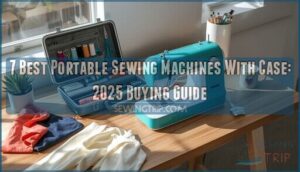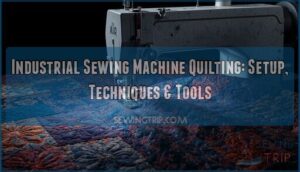This site is supported by our readers. We may earn a commission, at no cost to you, if you purchase through links.

In 2025, sewists have more options than ever. Online platforms like Seamwork, Indie Sew, and Mood Patterns offer incredible variety for all skill levels.
Free resources such as Pinterest and YouTube tutorials can help you find unique designs without breaking the bank.
Don’t overlook indie pattern designers who create innovative, size-inclusive collections. Subscription boxes from companies like Stitch Fix also provide curated patterns suited to your style.
Whether you’re a beginner or a seasoned pro, these sources will help you transform fabric into wearable art. Ready to discover your creative potential?
Table Of Contents
- Key Takeaways
- Understanding Pattern Making Basics
- Choosing The Right Fabric for Pattern Making
- Essential Tools for Pattern Creation
- 1. Smart H Adjustable Guide Sewing Machine Presser Foot
- 2. Quilting Patchwork Presser Foot
- 3. Elmers Disappearing Purple School Glue Sticks
- 4. Fiskars 60mm Titanium Rotary Cutter
- 5. Fiskars 45mm Rotary Cutter
- 6. Fiskars Forged Embroidery Scissors
- 7. Sewing Buttonhole Cutter Set
- 8. Fiskars Titanium Rotary Blades
- 9. Black Knit Elastic Spool
- Finding and Using Free Sewing Patterns
- 1 Best Pattern Sources for Various Sewing Needs
- Frequently Asked Questions (FAQs)
- Conclusion
Key Takeaways
- You’ll find a wealth of free and paid sewing patterns online through platforms like Seamwork, Pinterest, and indie designers, giving you endless creative possibilities for your projects.
- Don’t overlook the importance of choosing the right tools, like precise rotary cutters and specialized presser feet, which can dramatically improve the quality and precision of your pattern-making.
- Understanding basic pattern-making techniques like flat pattern drawing, drafting, and fashion draping will help you transform simple fabric into custom-fitted garments.
- Whether you’re a beginner or advanced sewist, exploring free patterns and resources can help you build skills, save money, and experiment with different styles without significant financial investment.
Understanding Pattern Making Basics
If you’ve ever dreamed of creating your own perfectly fitted garments, understanding pattern making basics is your first exciting step into the realm of sewing.
You’ll learn how to transform flat pieces of fabric into stunning, custom-tailored clothes that look like they were made just for you, which is a fundamental aspect of sewing.
Flat Pattern Drawing
Ever wondered how your favorite garments go from flat fabric to perfectly fitted clothing?
Flat pattern drawing is the secret sauce of clothing design, transforming 2D shapes into stunning 3D wearable art.
Fabric becomes poetry when flat patterns transform geometric lines into wearable art, stitch by inspired stitch.
It’s like being a fabric architect, where you’ll learn to craft pattern blueprints that bring your design visions to life.
- Master the art of shape transformation by understanding how geometric lines become custom-made garments
With flat pattern drawing, you’ll start with basic patterns and strategically manipulate them.
Think of it as creative problem-solving meets textile engineering.
You’ll trace, measure, and reshape designs with precision, turning simple sketches into clothing that fits like a dream.
It’s part science, part magic—where your creativity meets technical skill to create something truly unique.
Essential to this process are basic pattern making techniques.
Drafting
After nailing flat pattern drawing, drafting becomes your creative playground. Think of your sloper as a personal blueprint—a canvas waiting to transform.
Precise measurement is your secret weapon in pattern drafting, turning flat sketches into wearable art. Use your drafting tools like a sculptor, reshaping fabric with strategic darts and precise cuts.
Pattern alterations let you customize designs that hug your curves perfectly. With practice, you’ll master the art of design transformation, turning basic pattern blocks into unique, personalized garments that speak your style language.
Your measurements, your rules, and this understanding will guide you to create garments that reflect your personal style.
Fashion Draping
After mastering flat pattern drawing, you’ll want to explore fashion draping—a dynamic method of transforming flat fabric into stunning 3D designs.
By pinning and manipulating muslin or calico fabric directly on a dress form, you’ll discover how fabric behaves in real space.
Fabric becomes art when you sculpt it with intention, transforming flat material into living, breathing design.
This hands-on technique lets you sculpt garments, understanding grain direction and design development intuitively.
Draping is like sketching with fabric, where your dress form becomes a canvas and your creativity transforms raw material into wearable art, stitch by inspired stitch, creating a truly wearable art.
Seam Allowance
Your trusty ruler becomes a pattern-making compass when traversing seam allowance territory. This critical margin determines how perfectly your fabric pieces connect, transforming rough drafts into polished garments.
- Standard seam allowances range from 3/8" to 5/8"
- Different fabrics require unique allowance strategies
- Grading seam edges helps eliminate bulky intersections
Pro sewists know that precise seam allowances aren’t just measurements—they’re the secret handshake between design and execution. Clip curves, finish edges, and watch your sewing patterns come alive with professional finesse.
Choosing The Right Fabric for Pattern Making
Choosing the right fabric can make or break your sewing project, so it’s essential to understand the unique characteristics of different materials.
Whether you’re working with delicate muslin for prototyping or sturdy calico for testing patterns, your fabric selection will determine the final look and feel of your handmade masterpiece.
Calico
Every serious sewist knows calico is the unsung hero of pattern making.
This lightweight, affordable cotton fabric is your secret weapon for testing designs without breaking the bank. Perfect for prototyping and pattern development, calico offers predictable drape and durability that mimics many final fabric types.
Knowing the fabric weight suggestions can further refine your pattern choices.
- Ideal for creating affordable skirt blocks
- Forgiving for first-time pattern experiments
- Versatile enough to match multiple fabric behaviors
Muslin
After exploring calico’s versatility, let’s spotlight muslin—your sewing project’s secret weapon.
This lightweight fabric is a game-changer for pattern prototyping and fit testing. Different muslin weights let you simulate various fabric behaviors without risking expensive materials.
Understanding specific fabric weights can help you choose the best option for your project. Pro sewists choose medium-weight muslin for most pattern work, pre-washing to prevent future shrinkage.
Mark adjustments directly on the fabric, treating each prototype like a blueprint for your final masterpiece. Whether you’re crafting a vintage-inspired dress or contemporary streetwear, muslin helps you nail the perfect fit before cutting into your dream fabric.
Essential Tools for Pattern Creation
You’ll need some trusty tools to turn your sewing dreams into reality, and we’re here to help you gear up for pattern creation success.
From precise rotary cutters to smart presser feet, these essential tools will transform your crafting game and make pattern-making feel like a breeze.
1. Smart H Adjustable Guide Sewing Machine Presser Foot
Need razor-sharp precision in your sewing projects? The Smart H Adjustable Guide Sewing Machine Presser Foot is your secret weapon.
This nifty tool transforms your sewing machine’s performance, helping you stitch straight lines like a pro. Compatible with most low shank machines from Brother to Janome, it offers unparalleled fabric guidance and stitch control.
The adjustable guide lets you customize your approach, whether you’re working on intricate sewing patterns or channel quilting. Pro tip: Check your specific machine model, as some Husqvarna and Kenmore models might require extra attention.
You can find the Smart H presser here for purchase. A small wobble when lifted won’t stop this game-changing presser foot from elevating your sewing supplies arsenal.
2. Quilting Patchwork Presser Foot
Your sewing machine’s secret weapon? The quilting patchwork presser foot. This precision marvel transforms your stitching game with its razor-sharp edge guide and precise markings.
- Perfect for 1/4" seam alignment
- Single-hole design prevents fabric bunching
- Ideal for 7mm feed dog machines
- Simplifies topstitching challenges
- Enhances fabric feed consistency
Imagine having a built-in GPS for your fabric – that’s what this foot delivers. No more wonky lines or uneven patchwork pieces. Whether you’re piecing together a quilt or tackling intricate sewing patterns, this foot guarantees your project looks professional. You can find a variety of quilting presser options online. It’s like having a master quilter guiding your hands, making complex sewing techniques feel effortless and fun.
3. Elmers Disappearing Purple School Glue Sticks
A humble Elmer’s Disappearing Purple Glue Stick could be your secret weapon in pattern-making.
Its vibrant purple dye lets you track exactly where you’re applying adhesive, eliminating guesswork during fabric and pattern preparation. The magic happens when it dries completely clear, leaving no residue behind.
Perfect for temporary fabric bonding and pattern alignment, these glue sticks are child-safe, non-toxic, and washable—a crafter’s dream companion.
Whether you’re testing sewing patterns or prepping intricate designs, this versatile tool sticks precisely where you need it.
Pro tip: its acid-free formula means your delicate patterns stay pristine, making it a must-have in your sewing supplies arsenal.
4. Fiskars 60mm Titanium Rotary Cutter
Every serious sewist knows a top-tier rotary cutter can make or break a project.
The Fiskars 60mm Titanium Rotary Cutter slices through thick materials like batting and foam with pro-level precision. Its titanium-coated blade stays sharp three times longer than standard steel, giving you clean cuts without constant replacements.
The ergonomic curved handle fits comfortably in your hand, reducing strain during marathon cutting sessions. A convenient sliding safety button protects your fingers when you’re not actively cutting.
Left-handed or right-handed, you’ll appreciate the clear cutting view and blade placement. With a lifetime warranty and easy maintenance, this rotary cutter is an investment that’ll keep your fabric projects looking sharp.
5. Fiskars 45mm Rotary Cutter
Slicing through fabric with surgical precision, the Fiskars 45mm Rotary Cutter transforms your sewing projects from amateur to professional.
This powerhouse tool delivers clean, accurate cuts across multiple fabric types, making pattern creation a breeze.
Why sewists love this game-changing tool:
- Blade Sharpness: Cuts through layers like a hot knife through butter
- Ergonomic Design: Comfortable loop handle prevents hand fatigue
- Safety Features: Sliding button guarantees blade protection
- Cutting Accuracy: Perfect for intricate pattern pieces
Whether you’re working with delicate cotton or sturdy denim, this rotary cutter promises consistent performance.
Its replaceable blade keeps your cutting edge sharp, guaranteeing your sewing projects start with professional-level precision.
6. Fiskars Forged Embroidery Scissors
Thread warriors, meet your precision weapon: Fiskars Forged Embroidery Scissors. These razor-sharp 4-inch blades transform delicate cutting tasks from frustrating to fabulous.
Crafted with double-loop handles that welcome both left and right-handed sewists, these forged steel scissors slice through embroidery, quilting, and intricate fabric work like a hot knife through butter.
Precision cutting
Your sewing toolkit deserves this game-changing upgrade – trust me, your threads will thank you.
7. Sewing Buttonhole Cutter Set
Got buttonholes that look like they’ve been attacked by a wild animal? A sewing buttonhole cutter set will be your precision partner in crime.
This compact toolkit transforms messy cuts into professional-looking finishes across various fabric types.
Here’s why sewists love this game-changing set:
- Multiple cutter types for different buttonhole sizes
- Ergonomic design for comfortable handling
- Sharp blades that slice through fabric like butter
Proper cutter maintenance keeps your tools razor-sharp.
Always test cuts on scrap fabric first to guarantee clean lines and prevent costly mistakes.
Whether you’re working on delicate silk or sturdy denim, these cutters adapt to your sewing patterns with surgical precision.
Your seams will thank you later!
8. Fiskars Titanium Rotary Blades
When you’re ready to level up your sewing game, Fiskars Titanium Rotary Blades are your secret weapon.
Crafted to be three times harder than steel, these precision-ground blades maintain blade sharpness that’ll make your cutting experience smoother than silk.
Whether you’re tackling multiple fabric layers, batting, or foam, these blades slice through materials with professional-grade precision.
The innovative snap-in/snap-out design means blade replacement is a breeze—no more wrestling with complicated mechanisms.
Pair them with your trusty rotary cutter for impeccable curves and razor-straight lines that’ll make your sewing projects pop.
Pro tip: Always prioritize blade safety.
Store your Fiskars blades in the included tray to keep your workspace organized and your fingers protected.
9. Black Knit Elastic Spool
After your precision-cutting adventures with those Fiskars rotary blades, let’s talk about another sewing superhero: the black knit elastic spool.
This versatile sewing supply is your secret weapon for creating professional-looking waistbands and cuffs. With an 85% polyester and 15% rubber composition, it delivers reliable elastic tension that won’t quit.
Whether you’re crafting jackets, gloves, or even horse blankets, this spool has your back. Its one-directional stretch guarantees smooth performance, and being preshrunk means no unexpected surprises in the wash.
Knit elastic adapts to your project’s needs, providing comfort and flexibility where traditional elastic falls short.
Pro tip: always keep a spool in your sewing supplies—you’ll thank me later, as it is a crucial element for achieving professional-looking results with reliable elastic tension.
Finding and Using Free Sewing Patterns
You’re about to discover a treasure trove of free sewing patterns that can transform your crafting journey without breaking the bank.
Whether you’re a beginner or a seasoned sewist, these resources will help you discover endless creative possibilities and build your dream wardrobe from scratch.
Benefits of Free Patterns
Free patterns are the ultimate crafting compass for sewists looking to navigate their creative journey without breaking the bank!
They’re your secret weapon for skill-building and design exploration.
Here’s why these pattern gems are worth their weight in thread:
- Cost Savings – Zero dollars, maximum creativity
- Skill Boosting – Practice without pressure
- Design Playground – Experiment risk-free
- Community Connection – Shared learning experiences
- Confidence Builder – Transform beginner dreams into stitched realities
Where to Find Free Patterns
Dozens of treasure troves await sewists hunting for free sewing patterns online.
Explore digital libraries like Jennifer Rosbrugh’s Old Petticoat Shop, where vintage and modern digital patterns converge.
Facebook sewing communities burst with insider tips and shared resources, connecting hobbyists worldwide.
Bookmark brand websites and blogs—they’re goldmines for complimentary digital patterns perfect for beginners.
Pinterest offers a visual feast of downloadable sewing patterns across skill levels.
Platforms like Mood Fabrics and Peppermint Mag curate professional-quality free patterns that’ll spark your creativity and save you cash.
Your sewing adventure starts here!
Evaluating Free Pattern Quality
Not all free sewing patterns are created equal!
Before downloading, ask yourself:
- **Does this pattern promise Construction Ease?
- **Will it deliver Fit Accuracy for my body type?
- **Are the Instructions Clarity and Style Versatility worth my time?
Snag patterns that look professional, offer multiple sizes, and come with clear, step-by-step guidance.
Many sites offer free sewing patterns suitable for various skill levels.
Your fabric and time are too precious to waste on sketchy Download Formats that’ll leave you frustrated.
1 Best Pattern Sources for Various Sewing Needs
You’ll want to explore the best pattern sources that match your sewing skills and style preferences.
Whether you’re a beginner or a seasoned sewist, there’s a perfect pattern source waiting to help you create stunning, personalized garments that’ll make your wardrobe sing.
Anna Allen

If you’re hunting for sewing patterns that blend timeless charm with modern versatility, Anna Allen’s collection is your perfect match.
Her designs speak to sewists of all skill levels, offering everything from beginner-friendly to advanced patterns. Many resources, like Mood Fabrics designs, offer high-quality patterns and tutorials.
Whether you’re crafting a capsule wardrobe or exploring pattern adaptations, Allens Style promises sustainable, stylish results.
| Pattern Type | Skill Level | Design Aesthetic | Complexity | Fabric Recommendations |
|---|---|---|---|---|
| Versatile | Beginner-Advanced | Timeless | Low-High | Natural, Sustainable |
| Capsule Wardrobe | Intermediate | Modern | Medium | Organic Fabrics |
| Adaptable | Professional | Classic | High | Eco-Friendly Materials |
| Minimalist | All Levels | Chic | Variable | Linen, Cotton |
| Innovative | Experimental | Contemporary | Complex | Recycled Textiles |
The table provides a detailed overview of the various pattern types, including skill level, design aesthetic, complexity, and fabric recommendations, ensuring that sewists can make informed decisions about their projects.
Frequently Asked Questions (FAQs)
What is the best material to trace sewing patterns?
You’ll want oaktag or Manila paper for tracing patterns.
These durable materials are perfect for preserving your designs, allowing precise markings and multiple uses without tearing or stretching during your sewing projects.
Who are the big 4 sewing patterns?
Like finding the perfect dance partners, the big 4 sewing pattern companies – Simplicity, McCall’s, Butterick, and Vogue – have been your trusty companions.
They offer everything from casual wear to haute couture designs for sewists of all skill levels.
What do tailors use for patterns?
You’ll rely on several key tools for pattern-making: muslin fabric for prototypes, drafting paper, measuring tape, and sloper blocks.
Professional tailors use flat pattern drawing and fashion draping techniques to create precise, custom garment patterns.
How to find a pattern for sewing?
Unravel the fabric of creativity like a treasure map leading to sewing patterns.
Explore online platforms, local fabric stores, indie designers’ websites, and sewing communities.
Plunge into digital downloads, vintage collections, and free resources that spark your imagination.
What is the best material to make sewing patterns out of?
Opt for oaktag or Manila paper when creating sewing patterns. These durable materials withstand multiple uses, provide crisp tracing lines, and won’t tear easily while drafting your perfect garment design.
What is the best pattern company for beginners?
Sail into sewing with Simplicity Patterns, your beginner’s compass!
They’re like a friendly mentor, offering clear instructions, diverse styles, and patterns that’ll boost your confidence from first stitch to fabulous finish.
What is a cheap alternative to tracing paper?
You can use wax paper, parchment paper, or freezer paper as cheap alternatives to tracing paper.
These household items work well for pattern tracing and won’t break the bank.
Just grab what’s in your kitchen drawer, it’s a cheap alternative.
Who are the Big 4 sewing patterns?
Stitch your way through sewing’s classic quartet: Simplicity, McCall’s, Butterick, and Vogue.
These iconic pattern brands have been your creative companions, offering designs that transform fabric into fashion for sewists of all skill levels, making them a perfect choice for those who want to create fashion.
How do I adapt patterns for different body types?
Measure carefully and compare your body measurements to the pattern’s size chart.
Adjust pattern pieces by grading, adding darts, or using muslins to test fit.
Customize seam allowances and learn basic pattern alterations for your unique shape.
Whats the best way to organize my pattern collection?
Create a pattern binder with clear plastic sleeves, categorize by type and difficulty, and digitize with labeled folders.
Snap photos of finished projects next to each pattern for easy reference and inspiration.
Conclusion
Sew your dreams into reality with these best pattern sources for every sewing need.
From online platforms to indie designers, you’ve got a treasure trove of creative possibilities at your fingertips.
Whether you’re a newbie or a seasoned stitcher, these resources will transform your fabric into wearable art.
Embrace your inner designer, explore new techniques, and let your imagination run wild.
Your sewing journey starts now – stitch by stitch, pattern by pattern, and remember to always sew your dreams into reality.

